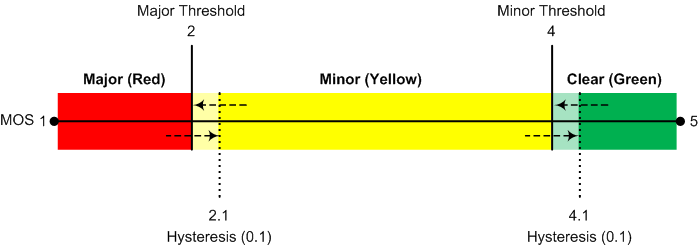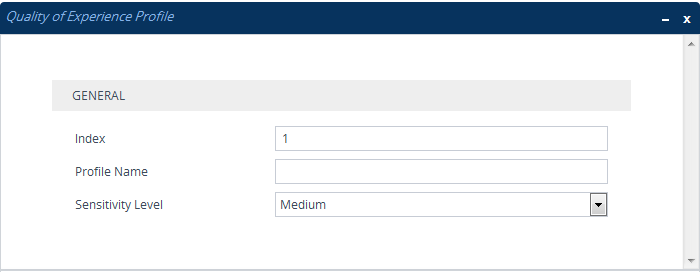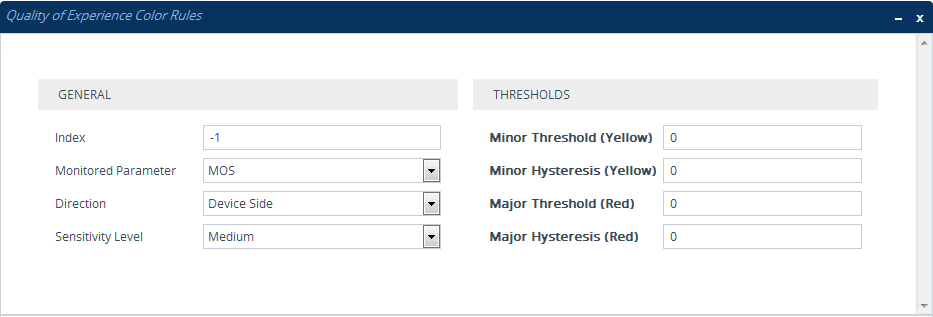Configuring Quality of Experience Profiles
Quality of Experience Profiles enable you to effectively monitor the quality of voice calls traversing the device in your network. Quality of Experience Profiles define severity thresholds for voice metrics monitored by the device, which if crossed can result in various actions (discussed later in the section).
Quality of Experience is configured using two tables with parent-child relationship. The Quality of Experience Profile table is the parent, which defines the name of the Quality of Experience Profile. The Quality of Experience Color Rules table is the child, which defines severity thresholds per voice metric for the specific Quality of Experience Profile. You can configure up to 256 Quality of Experience Profiles and up to 256 Quality of Experience Color Rules.
Once configured, you can apply the Quality of Experience Profiles to specific calls (network links), by assigning them to any of the following configuration entities:
| ■ | IP Groups (see Configuring IP Groups) |
| ■ | Media Realms (see Configuring Media Realms) |
| ■ | Remote Media Subnets (see Configuring Remote Media Subnets) |
The Quality of Experience Profile allows you to configure thresholds for the following monitored voice metrics:
| ■ | Mean Opinion Score (MOS): MOS is the average grade on a quality scale, expressed as a single number in the range of 1 to 5, where 1 is the lowest audio quality and 5 the highest audio quality. |
| ■ | Delay (or latency): Time it takes for information to travel from source to destination (round-trip time). |
| ■ | Packet Loss: Lost packets are RTP packets that are not received by the voice endpoint. Packet loss can result in choppy voice transmission. |
| ■ | Jitter: Jitter can result from uneven delays between received voice packets. To space evenly, the device's jitter buffer adds delay. The higher the measurement, the greater the impact of the jitter buffer's delay on audio quality. |
| ■ | Residual Echo Return Loss (RERL): An echo is a reflection of sound arriving at the listener at some time after the sound was initiated (often by the listener). Echo is typically caused by delay. |
At any given time during a call, a voice metric can be in one of the following color-coded quality states (as displayed in OVOC):
| ■ | Green: Indicates good call quality |
| ■ | Yellow: Indicates fair call quality |
| ■ | Red: Indicates poor call quality |
When the threshold of a voice metric is crossed, the device changes the alarm severity and corresponding color-coded quality state of the call:
| ■ | Minor Threshold (Yellow): Lower threshold that indicates changes from Green or Red to Yellow. |
| ■ | Major Threshold (Red): Higher threshold that indicates changes from Green or Yellow to Red. |
The device also uses hysteresis to determine whether the threshold has indeed being crossed. Hysteresis defines the amount of fluctuation from the threshold in order for the threshold to be considered as crossed (i.e., change in color state). Hysteresis is used to avoid false reports being sent by the device. Hysteresis is used only for threshold crossings toward a lesser severity (i.e., from Red to Yellow, Red to Green, or Yellow to Green).
The following example is used to explain how the device considers threshold crossings. The example is based on the MOS of a call, where the Major threshold is configured to 2, the Minor threshold to 4 and the hysteresis for both thresholds to 0.1:

Threshold Crossings based on Threshold and Hysteresis
|
Threshold Crossing |
Calculation |
Threshold based on Example |
|---|---|---|
|
Green to Yellow (Minor alarm) |
The change occurs if the measured metric crosses the configured Minor threshold only (i.e., hysteresis is not used). |
4 |
|
Green to Red (Major alarm) |
The change occurs if the measured metric crosses the configured Major threshold only (i.e., hysteresis is not used). |
2 |
|
Yellow to Red (Major alarm) |
The change occurs if the measured metric crosses the configured Major threshold only (i.e., hysteresis is not used). |
2 |
|
Red to Yellow (Minor alarm) |
The change occurs if the measured metric crosses the configured Major threshold with hysteresis configured for the Major threshold. |
2.1 (i.e., 2 + 0.1) |
|
Red to Green (alarm cleared) |
The change occurs if the measured metric crosses the configured Minor threshold with hysteresis configured for the Minor threshold. |
4.1 (i.e., 4 + 0.1) |
|
Yellow to Green (alarm cleared) |
The change occurs if the measured metric crosses the configured Minor threshold with hysteresis configured for the Minor threshold. |
4.1 (i.e., 4 + 0.1) |
Each time a voice metric threshold is crossed (i.e., color changes), the device can do the following depending on configuration:
| ■ | Report the change in the measured metrics to |
| ■ | Depending on the crossed threshold type, you can configure the device to reject calls to the destination IP Group or use an alternative IP Profile for the IP Group. For more information, see Configuring Quality of Service Rules. |
| ■ | Alternative routing based on measured metrics. If a call is rejected because of a crossed threshold, the device generates a SIP 806 response. You can configure this SIP response code as a reason for alternative routing (see Configuring SIP Response Codes for Alternative Routing Reasons). |
For your convenience, the device provides pre-configured Quality of Experience Profiles. One of these pre-configured profiles is the default Quality of Experience Profile, which is used if you do not configure a Quality of Experience Profile.
The following procedure describes how to configure Quality of Experience Profiles through the Web interface. You can also configure it through other management platforms:
| ■ | Quality of Experience Profile table: ini file [QoEProfile] or CLI (configure voip > qoe qoe-profile) |
| ■ | Quality of Experience Color Rules table: ini file [QOEColorRules] or CLI (configure voip > qoe qoe-color-rules) |
| ➢ | To configure a QoE Profile: |
| 1. | Open the Quality of Experience Profile table (Setup menu > Signaling & Media tab > Media folder > Quality of Experience > Quality of Experience Profile). |
| 2. | Click New; the following dialog box appears: |

| 3. | Configure a QoE Profile according to the parameters described in the table below. |
| 4. | Click Apply. |
Quality of Experience Profile Table Parameter Descriptions
|
Parameter |
Description |
||||||||||||
|---|---|---|---|---|---|---|---|---|---|---|---|---|---|
|
'Index' [Index] |
Defines an index number for the new table row. Note: Each row must be configured with a unique index. |
||||||||||||
|
'Profile Name' name [Name] |
Defines a descriptive name, which is used when associating the row in other tables. The valid value is a string of up to 20 characters. Note: The parameter value cannot contain a forward slash (/). |
||||||||||||
|
'Sensitivity Level' sensitivity-level [SensitivityLevel] |
Defines the pre-configured threshold profile to use.
|
| 5. | In the Quality of Experience Profile table, select the row for which you want to configure QoE thresholds, and then click the Quality of Experience Color Rules link located below the table; the Quality of Experience Color Rules table appears. |
| 6. | Click New; the following dialog box appears: |

| 7. | Configure a rule according to the parameters described in the table below. |
| 8. | Click New, and then save your settings to flash memory. |
Quality of Experience Color Rules Table Parameter Descriptions
|
Parameter |
Description |
|||||||||||||||||||||
|---|---|---|---|---|---|---|---|---|---|---|---|---|---|---|---|---|---|---|---|---|---|---|
| General | ||||||||||||||||||||||
|
'Index' index [QOEColorRules_ColorRuleIndex] |
Defines an index number for the new table row. Note: Each row must be configured with a unique index. |
|||||||||||||||||||||
|
'Monitored Parameter' monitored-parameter [QOEColorRules_monitoredParam] |
Defines the parameter to monitor and report.
|
|||||||||||||||||||||
|
'Direction' direction [QOEColorRules_direction] |
Defines the monitoring direction.
|
|||||||||||||||||||||
|
'Sensitivity Level' sensitivity-level [QOEColorRules_profile] |
Defines the sensitivity level of the thresholds.
|
|||||||||||||||||||||
|
Thresholds |
||||||||||||||||||||||
|
'Minor Threshold (Yellow)' minor-threshold-yellow [QOEColorRules_MinorThreshold] |
Defines the Minor threshold value, which is the lower threshold located between the Yellow and Green states. To consider a threshold crossing:
The valid threshold values are as follows:
|
|||||||||||||||||||||
|
'Minor Hysteresis (Yellow)' minor-hysteresis-yellow [QOEColorRules_MinorHysteresis] |
Defines the amount of fluctuation (hysteresis) from the Minor threshold, configured by the 'Minor Threshold (Yellow)' parameter in order for the threshold to be considered as crossed. The hysteresis is used only to determine threshold crossings to Green (i.e., from Yellow to Green, or Red to Green). In other words, the device considers a threshold crossing to Green only if the measured voice metric crosses the Minor threshold and the hysteresis. For example, if you configure the 'Minor Threshold (Yellow)' parameter to 4 and the 'Minor Hysteresis (Yellow)' parameter to 0.1 (for MOS), the device considers a threshold crossing to Green only if the MOS crosses 4.1 (i.e., 4 + 0.1). |
|||||||||||||||||||||
|
'Major Threshold (Red)' major-threshold-red [QOEColorRules_MajorThreshold] |
Defines the Major threshold value, which is the upper threshold located between the Yellow and Red states. To consider a threshold crossing:
The valid threshold values are as follows:
|
|||||||||||||||||||||
|
'Major Hysteresis (Red)' major-hysteresis-red [QOEColorRules_MajorHysteresis] |
Defines the amount of fluctuation (hysteresis) from the Major threshold, configured by the 'Major Threshold (Red)' parameter in order for the threshold to be considered as crossed. The hysteresis is used only to determine threshold crossings from Red to Yellow. In other words, the device considers a threshold crossing to Yellow only if the measured voice metric crosses the Major threshold and the hysteresis. For example, if you configure the 'Major Threshold (Red)' parameter to 2 and the 'Major Hysteresis (Red)' parameter to 0.1 (for MOS), the device considers a threshold crossing to Yellow only if the MOS crosses 2.1 (i.e., 2 + 0.1). |
|||||||||||||||||||||